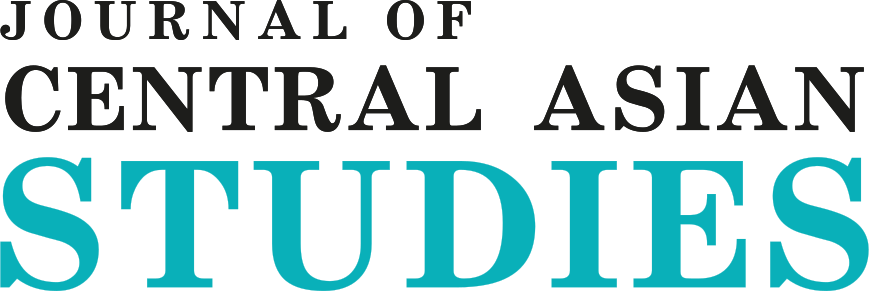Орталық Азиядағы әлеуметтік өзгерістер: сандар мен тенденциялар
DOI:
https://doi.org/10.52536/3006-807X.2024-3.01Кілт сөздер:
Орталық Азиядағы әлеуметтік өзгерістер, адам капиталы, демографиялық өзгерістер, әлеуметтік даму, халық санының өсуіАңдатпа
Орталық Азия елеулі өзгерістерді бастан кешіріп, халықаралық аренада кемел тәуелсіз мемлекеттерге айналып, әлеуметтік-демографиялық өзгерістерден өтуде. Бұл Мойзес Наймның «Биліктің соңы» кітабында сипатталған динамикаға ұқсайды, онда ол «көптік, ұтқырлық және менталитет» революциялары тұрақсыз және болжауға мүмкін емес орталарды құру арқылы саяси көшбасшылар үшін жаңа сын-қатерлер пайда болуын баяндайды. Бұл мақаланың мақсаты аймақтық контекстіде бұл болжамды тексеру үшін Орталық Азиядағы әлеуметтік-демографиялық өзгерістерге эмпирикалық талдау жүргізу болып табылады.
Әдебиеттер тізімі
(n.d.). Retrieved from https://dataexplorer.unescap.org/
(n.d.). Retrieved from https://datahub.itu.int/query/
(n.d.). Retrieved from https://dataexplorer.unescap.org/
(n.d.). Retrieved from https://eurasianet.org/kyrgyzstan-national-bank-predicts-20-decline-in-remittances
Abraham, K., & Mallatt, J. (2022). Measuring Human Capital. The Journal of Economic Perspectives, 36(3), 103–130.
Acemoglu, D. (2003). Patterns of Skill Premia. Review of Economic Studies, 70(2), 199–230.
Becker, S., Rubin, J., & Woessmann, L. (2021). Religion in economic history: A survey. The handbook of historical economics, 585-639.
Belekov, Z. (2011). Особенности внутренней миграции в Кыргызской Республике [Features of internal migration in the Kyrgyz Republic]. Bulletin of KazNU, 32(1), 8-12. Retrieved from https://articlekz.com/article/8541
Birth rate, crude (per 1000 people). (2023, August 19). Retrieved from World Bank: https://data.worldbank.org/indicator/SP.DYN.CBRT.IN?end=2021&locations=KZ-UZ-KG-TJ-TM&start=1991&view=chart
Björklund, A., & Kjell, S. (2011). Education and Family Background: Mechanisms and Policies. In E. A. Hanushek, S. J. Machin, & L. Woessmann (Eds.), Handbook of the Economics of Education (Vol. 3, pp. 201-247). Amsterdam: North Holland.
Caselli, F., & Ciccone, A. (2019). The Human Capital Stock: A Generalized Approach: Comment. American Economic Review, 109(3), 1155-1174.
Clark, J. (1899). The distribution of wealth. New York: Macmillan.
Cohen, D., & Soto, M. (2007). Growth and Human Capital: Good Data, Good Results. Journal of Economic Growth, 12(1), 51–76.
Demirgüç-Kunt, A., & Torre, I. (2020). Measuring Human Capital in Europe and Central Asia. World Bank Policy Research Working Paper(9458), 47. doi:http://dx.doi.org/10.2139/ssrn.3720333
Fix, B. (2021). The Rise of Human Capital Theory. Real-World Economics Review(95), 29-41.
Isiksal, A., Assi, A., Zhakanov, A., Rakhmetullina, S., & Joof, F. (2022). Natural resources, human capital, and CO2 emissions: Missing evidence from the Central Asian States. Environmental Science and Pollution Research, 29(51), 77333-77343.
Jones, B. (2014). The Human Capital Stock: A Generalized Approach. American Economic Review, 104(11), 3752–3777.
Klomp, J., & de Haan, J. (2013). Political Regime and Human Capital: A Cross-Country Analysis. Social Indicators Research, 111(1), 45–73.
Kurz, H. (2018). Power – the bête noire in much of modern economics. Artha Vijnana, 60(4), 319-376.
Life expectancy at birth, total (years). (2023, August 19). Retrieved from World Bank: https://data. worldbank.org/indicator/SP.DYN.LE00.IN?end=2020&locations=KZ-KG-UZ-TJ-TM&start=2011
Liu, G., & Fraumeni, B. (2020). A Brief Introduction to Human Capital Measures. NBER Working Paper 27561, 17.
Marx, K. (1954). Capital, 1st ed. in German 1867; 4th ed. 1890. English ed. (Vol. I). London: Lawrence and Wishart, [1867].
Mokyr, J. (2017). A Culture of Growth. The Origins of the Modern Economy. Princeton and Oxford: Princeton University Press.
Nitzan, J., & Bichler, S. (2009). Capital as power: A study of order and reorder. New York: Routledge.
Note: 71 mln is the sum of number of sim cards in each country. “How is Mobile Communications and the Internet Developing in Central Asia? (2021, October 25). Retrieved from Cabar: https://cabar.asia/en/how-is-mobile-communications-and-the-internet-developing-in-central-asia
Ovezmyradov, B., & Kepbanov, Y. (2021). Human capital and liberalization in Central Asia: comparative perspectives on development (1991 – 2020). Research report in Sociology of Law(3), 145.
Piketty, T. (2014). Capital in the twenty-first century. Cambridge: Harvard University Press.
Rubin, J. (2017). Rulers, Religion, and Riches: Why the West Got Rich and the Middle East Did Not. Cambridge: Cambridge University Press.
Seitz, W. (2023). Свобода передвижения и доступность жилья [Freedom of movement and affordable housing]. Retrieved from World bank: https://documents1.worldbank.org/curated/en/342251578945240423/pdf/Free-Movement-and-Affordable-Housing-Public-Preferences-for-Reform-in-Uzbekistan.pdf
Shabalin, A. (2022, July 21). По территории как Евросоюз, а по экономике как Чили. Центральная
Азия в цифрах [In terms of territory, like the European Union, and in terms of economy, like Chile. Central
Asia in numbers]. Retrieved from Kaktus media: https://kaktus.media/doc/463984_po_territorii_kak_
evrosouz_a_po_ekonomike_kak_chili._centralnaia_aziia_v_cifrah.html#:~:text=
В%20странах%20Центральной%20Азии%20живет,лет%2C%20Евросоюза%
%2D%2044%20годаStoll, H. (2023, October 12). A Case for Greater U.S. Engagement in Central Asia, Commentary. Retrieved from The Diplomat: https://www.rand.org/blog/2023/09/a-case-for-greater-us-engagement-in-centralasia.html
Weber, M. (2012). The Protestant Ethic and the Spirit of Capitalism. (S. Kalberg, Trans.) London: Routledge.
Wicksteed, P. (1932). An essay on the co-ordination of the laws of distribution. London: London School of Economics.
Yormirzoev, M. (2023). Human capital and economic growth in Central Asia. Post-Communist Economies, 35(6), 533-545.
Более 1 млн казахстанцев ежегодно становятся мигрантами внутри страны [More than 1 million Kazakhstanis annually become migrants within the country]. (2021, September 10). Retrieved from Forbes: https://forbes.kz/process/resources/riski_i_vyizovyi_vnutrenney_i_vneshney_
migratsii/
Как спад денежных переводов из России отразится на Центральной Азии? [How will the decline in remittances from Russia affect Central Asia?]. (2022, September 30). Retrieved from Inbusiness: https://inbusiness.kz/ru/news/kak-spad-denezhnyh-perevodov-iz-rossii-otrazitsya-na-centralnoj-azii
Узбеки в США: переезд, адаптация, открытие бизнеса [Uzbek in US: moving, adaptation, opening business]. (2020, May 23). Retrieved from Weproject: https://weproject.media/articles/detail/uzbeki-vssha-pereezd-adaptatsiya-otkrytie-biznesa/
Уровень урбанизации в Казахстане достиг 61,5% [The Level of Urbanization Reached 61,5%]. (2023, March 14). Retrieved from Turan Times: https://turantimes.kz/obschestvo/41663-uroven-urbanizaciiv-kazahstane-dostig-615.html#:~:text=По%20итогам%202022%20года%20уровень,%25%20
до%2061%2C5%25
Экономика Центральной Азии: новый взгляд [Economy of Central Asia: New View]. (2022). Retrieved from Eurasian Development Bank: https://eabr.org/upload/iblock/d0b/EDB_2022_Report-3_The-Economy-of-CA_rus.pdf
Жүктеулер
Жарияланды
Журналдың саны
Бөлім
Лицензия
Авторлық құқық (c) 2024 Тұқымов Е., Құрмашев А.

Бұл жұмыс Creative Commons атрибуты бойынша лицензияланған. 4.0 Халықаралық лицензия.











 Open content is licensed under the CC-BY
Open content is licensed under the CC-BY 